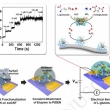댓글 쓰기 권한이 없습니다. 로그인 하시겠습니까?
Feasibility study for combination of ?eld-?ow fractionation(FFF)-based separation of size-coded particle probes with ampli?ed surface enhanced Raman scattering (SERS) tagging for simultaneous detection of multiple miRNAs
| Journal | Journal of Chromatography A |
|---|---|
| Author | Kayeong Shin, Jaeyeong Choi, Yeoju Kim, Yoonjeong Lee, Joohoon Kim, Seungho Lee,, Hoeil Chung |
| Citation | J .Chromatogr. A 1556(2018) 97?102 |
| DOI | https://doi.org/10.1016/j.chroma.2018.04.057 |

We propose a new analytical scheme in which field-flow fractionation (FFF)-based separation of target-specific polystyrene (PS) particle probes of different sizes are incorporated with amplified surface-enhanced Raman scattering (SERS) tagging for the simultaneous and sensitive detection of multiple microRNAs (miRNAs). For multiplexed detection, PS particles of three different diameters (15, 10, 5?μm) were used for the size-coding, and a probe single stranded DNA (ssDNA) complementary to a target miRNA was conjugated on an intended PS particle. After binding of a target miRNA on PS probe, polyadenylation reaction was executed to generate a long tail composed of adenine (A) serving as a binding site to thymine (T) conjugated Au nanoparticles (T-AuNPs) to increase SERS intensity. The three size-coded PS probes bound with T-AuNPs were then separated in a FFF channel. With the observation of extinction-based fractograms, separation of three size-coded PS probes was clearly confirmed, thereby enabling of measuring three miRNAs simultaneously. Raman intensities of FFF fractions collected at the peak maximum of 15, 10 and 5?μm PS probes varied fairy quantitatively with the change of miRNA concentrations, and the reproducibility of measurement was acceptable. The proposed method is potentially useful for simultaneous detection of multiple miRNAs with high sensitivity.
-
Read More

Electrochemical Functionalization of Single-Walled Carbon Nanotubes with Amine-Terminated Dendrimers Encapsulating Pt Nanoparticles: Toward Facile Field-Effect Transistor-Based Sensing Platforms
Category2018 AuthorLee, Chang-Seuk; Ju, Youngwon; Kim, Joohoon; Kim, Tae Hyun JournalSensors and Actuators, B: Chemical CitationSensors and Actuators, B: Chemical Volume275 Pages367-372
-
Read More

Blue Photoluminescence of Au Nanoclusters Synthesized Using Dendrimer Templates under Mild Conditions
Category2018 AuthorJun Myung Kim Hyeong Seop Shim Jihye Kwon Hai Dong Kim Jae Kyu Song Joohoon Kim JournalBULLETIN OF THE KOREAN CHEMICAL SOCIETY CitationBull. Korean Chem. Soc. 2018, Vol. 39, 1324?1327
-
Read More

Feasibility study for combination of ?eld-?ow fractionation(FFF)-based separation of size-coded particle probes with ampli?ed surface enhanced Raman scattering (SERS) tagging for simultaneous detection of multiple miRNAs
Category2018 AuthorKayeong Shin, Jaeyeong Choi, Yeoju Kim, Yoonjeong Lee, Joohoon Kim, Seungho Lee,, Hoeil Chung JournalJournal of Chromatography A CitationJ .Chromatogr. A 1556(2018) 97?102
-
Read More

Near-infrared electrochemiluminescence from orange fluorescent Au nanoclusters in water
Category2018 AuthorJun Myung Kim, Seonghyun Jeong, Jae Kyu Song, Joohoon Kim JournalChemical Communications CitationChem. Commun., 2018, 54, 2838
-
Read More

Repetitively Coupled Chemical Reduction and Galvanic Exchange as a Synthesis Strategy for Expanding Applicable Number of Pt Atoms in Dendrimer-Encapsulated Pt Nanoparticles
Category2018 AuthorTaehoon Cho, Changwon Yoon, Joohoon KIM JournalLangmuir CitationLangmuir 34, 25, 7436-7444
Designed by sketchbooks.co.kr / sketchbook5 board skin
Sketchbook5, 스케치북5
Sketchbook5, 스케치북5
Sketchbook5, 스케치북5
Sketchbook5, 스케치북5
.png)


 Blue Photoluminescence of Au Nanoclusters Synthesiz...
Blue Photoluminescence of Au Nanoclusters Synthesiz...
 Near-infrared electrochemiluminescence from orange fl...
Near-infrared electrochemiluminescence from orange fl...